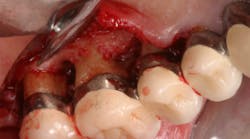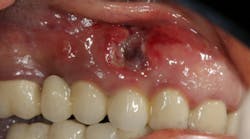Established ridge-split procedure offers new application in dental implant surgery
Journal of Oral Implantology — Dental techniques to modify the alveolar ridge have been around for many years, often as a means of support for dentures. As dental implants have now become common procedures, so has preimplant preparation of the bone. The ridge-split procedure is one such method of widening and augmenting the alveolar ridge that is finding renewed interest.
RELATED |Stronger bone for oral surgery created by introducing microcracks in the jawbone
RELATED |High-risk patients benefit from new techniques for computer-guided implant dentistry
The Journal of Oral Implantology presents a detailed description of the alveolar ridge-split procedure, supplemented by photographs. The alveolar ridge is the bony ridge on both the upper and lower jaws that contains the sockets of the teeth. Establishing an alveolar ridge of proper dimensions has become essential with the advent of root-form endosseous dental implants, the most common type of implants.
The ridge-split procedure described in this article is a form of ridge widening or augmentation. In cases of narrow alveolar ridges, it has proven to be consistently successful. Use of this minimally invasive technique has many advantages in the preprosthetic stage of dental implants. Low risk of inferior alveolar nerve injury, less pain and swelling, and no need for a second surgical site as donor are among the benefits.
Because of differences in bone density, the ridge-split technique requires a single surgical stage in the maxilla, or upper jaw, and a two-stage approach in the mandible. The two stages of mandible surgery consist of corticotomy, a bone-cutting procedure, followed by splitting and grafting performed three to five weeks later. The staged approach of the ridge-split procedure has shown a higher implant success rate and better buccal cortical bone preservation.
A practitioner’s experience is an important component of this technique. This form of surgery modifies the configuration of the bone and is usually performed in a closed fashion and uses a tactile sense. The authors emphasize the need for careful manipulation of the thin ridge, knowledge of precise surgical principles, and specialized training.
Full text of the article, “Horizontal Augmentation Through the Ridge-Split Procedure: A Predictable Surgical Modality in Implant Reconstruction,” Journal of Oral Implantology, Vol. 39, No.1, 2013, is available here.
About Journal of Oral Implantology
The Journal of Oral Implantology is the official publication of the American Academy of Implant Dentistry and of the American Academy of Implant Prosthodontics. It is dedicated to providing valuable information to general dentists, oral surgeons, prosthodontists, periodontists, scientists, clinicians, laboratory owners and technicians, manufacturers, and educators. The JOI distinguishes itself as the first and oldest journal in the world devoted exclusively to implant dentistry. For more information about the journal or society, please visit http://www.joionline.org.






